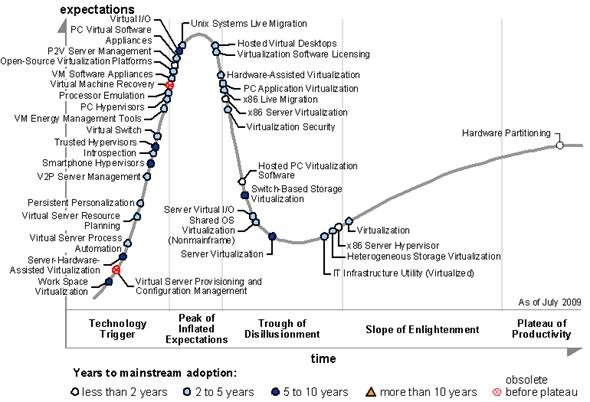In the next two to five years, Gartner predicts that virtualisation as a whole will have a transformational business impact.
Gartner defines IT virtualisation as the abstraction of IT resources in a way that masks the physical nature and boundaries of those resources from resource users. An IT resource can be a server, a client, storage, networks, applications, operating systems or a search engine.
"Virtualisation is not simply one technology, rather it is many technologies that are all evolving at different rates," said Thomas Bittman, vice president and distinguished analyst at Gartner. "There are many different forms of virtualisation, and the challenge is in choosing which form of virtualisation to use. Organisations should be cautious about vendors that promote one technology to manage everything as, in the end, architectures will include many different virtualisation layers, with many different management mechanisms."
"Virtualisation makes it easier for IT to deliver faster, to have a lower barrier to entry and to deliver only exactly what is needed - no more and no less," said Mr Bittman. "This puts more pressure on the user to use IT efficiently and to make good business decisions about the use of IT."
In less than two years, x86 server hypervisors will have a transformational business effect.
"Hypervisor-based virtualisation is a strategic technology that will become the default for most servers within three years," said Phil Dawson, research vice president at Gartner. "Server virtualisation technology reduces hardware costs through server consolidation and by increasing hardware utilisation. Hypervisors further enable rapid server deployment, often increasing server deployment times by a factor of 30."
The flexibility enabled by hypervisors will give operations more freedom in workload hosting, and the potential ability in the future to migrate workloads in virtual machine (VM) format to cloud service providers. Gartner believes that, in the long term, this technology will become the basis for such processes as completely changing server chargeback, planned downtime management, capacity planning and disaster recovery.
Gartner also predicts that PC virtual software appliances will have a transformational business impact in the next two to five years.
A PC virtual software appliance is a dedicated PC partition or virtual machine providing a single application or function, without the complexity of a full PC operating system (OS). By adopting an appliance approach, organisations will be able to deliver individual functions (such as firewalls, asset management, TV recorders or media players) as separate modules that run alongside, rather than on top of (or from within), the standard PC OS.
"PC virtual software appliances will accelerate product innovation cycles for suppliers and result in faster load times for users. They will become a major PC development platform, rivaling OS integration as a major focus of the PC industry's R&D efforts for targeted security and management functions," said Brian Gammage, vice president and Gartner Fellow. "However, broad mainstream implementation will require a client hypervisor standard, which is still emerging."
Gartner predicts that once hypervisors are offered with new PCs, virtual appliances will allow PC vendors to establish functional differentiation between products based on the same hardware components. Their use will also become essential for delivering some platform-level functions (such as disc encryption and power management) on PCs that run multiple virtual machines.
Hype Cycle for Virtualisation, 2009
Virtualisation will be further examined at the Gartner Data Center Summit 2009, 5-6 October in London. For further information please visit www.europe.gartner.com/...
The virtualisation hype cycle is part of "Gartner's Hype Cycle Special Report for 2009." It evaluates the maturity of 1,650 technologies and trends in 79 technology, topic and industry areas.
About Gartner Hype Cycles
Gartner produces a series of Hype Cycles to help separate hype from reality and provide a model that helps businesses to decide when they should adopt a new technology based on current maturity and risk.
The Hype Cycle is an educational tool that helps explain why technologies should be adopted based on your individual needs and goals, rather than on the generic levels of hype and disillusionment in the marketplace. Gartner's Hype Cycle Model follows four stages:
Technology Trigger - The first phase of a Hype Cycle is the "technology trigger" or breakthrough, product launch or other event that generates significant press and interest.
Peak of Inflated Expectations - In the next phase, a frenzy of publicity typically generates over-enthusiasm and unrealistic expectations. There may be some successful applications of a technology, but there are typically more failures.
Trough of disillusionment - Technologies enter the "trough of disillusionment" because they fail to meet expectations and quickly become unfashionable. Consequently, the press usually abandons the topic and the technology.
Slope of enlightenment - Although the press may have stopped covering the technology, some businesses continue through the "slope of enlightenment" and experiment to understand the benefits and practical application of the technology.
Plateau of Productivity - A technology reaches the "plateau of productivity" as the benefits of it become widely demonstrated and accepted. The technology becomes increasingly stable and evolves in second and third generations. The final height of the plateau varies according to whether the technology is broadly applicable or benefits only a niche market.


